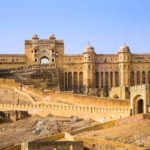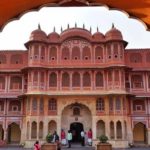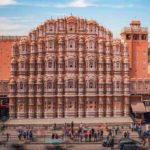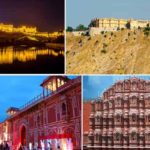Why Hawa Mahal Is Famous? Jaipur is considered as one of the most iconic attractions of the city. The five-storey building looks like a honeycomb of a beehive and it is always windy inside, owing to the numerous windows and jharokhas. This amazing ventilation that the palace enjoys is the reason why it was named as the Hawa Mahal, which literally translates into the “Palace of the Winds”.
The main purpose behind the construction of this palace was to allow the ladies of the royal family and the court to observe the busy streets of the Johari Bazaar from the many jharokhas of the palace, without being seen themselves. The Hawa Mahal is a five-storey building, and it is the tallest building in the world that has been built without a foundation. It has a curved architecture that leans at an 87 degree angle, and a pyramidal shape which has helped it stay erect for centuries.
The Hawa Mahal is dedicated to Lord Krishna. It is said that the shape of the building resembles the crown of Krishna. More than a palace, the Hawa Mahal is also a cultural and architectural marvel that reflects a truly harmonious amalgamation of the Hindu Rajput and Islamic Mughal architectural styles. The Rajput style can be seen in the domes canopies and the fluted pillars, while the stone inlay filigree work and the arches are perfect depictions of the Mughal style of architecture Rajasthan Monuments.
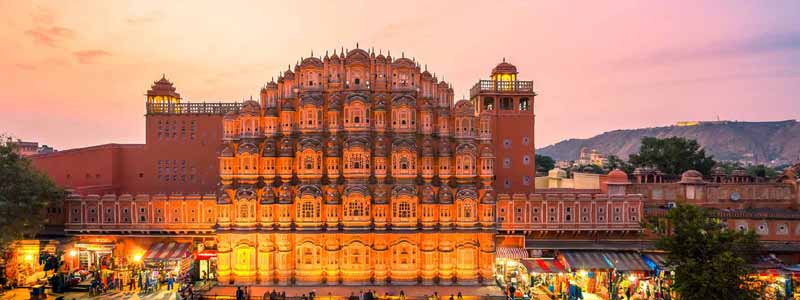
11 Fun Facts about Hawa Mahal in Jaipur: Wonders of India
- Hawa Mahal is one of the most famous ancient monuments of Rajasthan. Hawa Mahal was built in 1799 A.D by Maharaja Sawai Pratap Singh.
- Hawa Mahal was built in 1799 A.D by Maharaja Sawai Pratap Singh.
- The words “Hawa Mahal” mean “Wind Palace.” Hawa Mahal is so called because it has about 953 windows through which the breeze flows and keeps the palace cool. All the Jaipur royals utilized this building as their summer retreat.
- Hawa Mahal was designed by Lal Chand Usta. The building was especially erected for the royal ladies of Jaipur. The purpose of this building was to allow the royal ladies to watch all the activities of the local marketplace without being seen.
- Hawa Mahal exhibits a unique combination of Mughal and Rajput architectural styles.
- It is carved out of red and pink sandstone.
- Hawa Mahal is the tallest building in the world without a foundation. Hawa Mahal has 5 storeys and it is still standing upright because it is curved and leaning at an angle of 87 degrees.
- Hawa Mahal is built in the shape of Lord Krishna’s crown.
- The lattice-work or the jaali work in the windows of Hawa Mahal is similar to the honeycomb of a beehive.
- Unlike conventional buildings, there is no front entrance to the Hawa Mahal. If you want to get in, you have to enter from the rear side.
- The Hawa Mahal has only ramps, instead of regular stairs to reach the upper floors of the building.
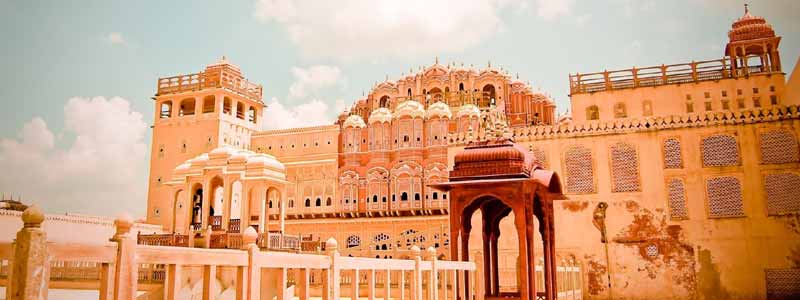
History of Hawa Mahal
The construction of the Hawa Mahal was facilitated by Maharaja Sawai Pratap Singh, the grandson of Maharaja Sawai Jai Singh II, the founder of the city of Jaipur. Throughout the rule of the Kachhwaha Rajput dynasty, only three rulers had been seen showcasing an interest in the development and advancement of the art, culture, architecture and the heritage of the society around them.
Among these was Maharaja Sawai Pratap Singh. The construction of the fort finally concluded in 1799. The main architect of the palace was Lal Chand Ustad. Inspired by the Khetri Mahal built by Maharaja Bhopal Singh in Jhunjhunu, Maharaja Sawai Pratap Singh, an ardent advocate of architectural development, employed Lal Chand Ustad to commence the construction of the Hawa Mahal as an extension of the City Palace.
Out of the innumerable reasons justifying the construction of Hawa Mahal or the ‘Palace of Wind’, two main reasons strive immeasurably beyond others. Both of them have logical backings however, instead of running in contrast to each other as different reasons most of the times, they have a complementary nature.
The first reason is supported by the norms of the patriarchal society that the Indian society has been summoned under for the longest time known. It is said that the Hawa Mahal was built to enable the royal women to look at and enjoy the public processions and events without being seen by the public.
The women could sit near the Jharokhas, which were small peepholes, and watch the everyday happening of the life outside the palace. This enabled them to enjoy a sense of freedom that they had so far been forbidden to, while still abiding by the laws and norms of the Purdah system.
Another reason that has been awarded to the construction of the Hawa Mahal is in synchronisation with the literal translation of its name, in essence, the ‘Palace of Wind’. Due to the 953 Jharokhas that adorned the Hawa Mahal, the palace was air conditioned even in the extreme temperatures of the summer months.
This was due to the creation of the Venturi effect, also known as the Doctor breeze. This provided an escape to the king and the royal women to enjoy their leisure time indulging in activities they wished to. This promoted their art and heritage immensely even if it was not outwardly visible Why Hawa Mahal Is Famous?.
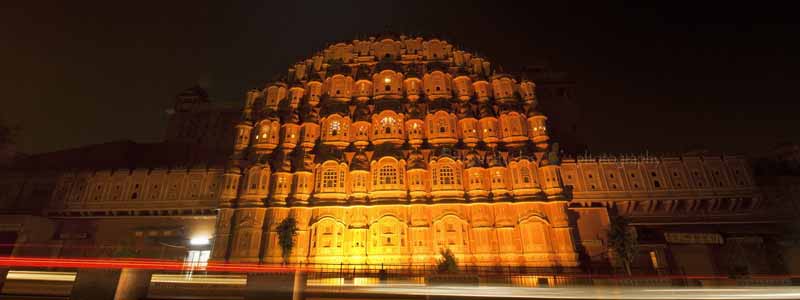
Architecture of Hawa Mahal
The Hawa Mahal is a five-storey monument with each storey housing a different side of the royal life. The five main structures inside the monument are: (a)Sharad Mandir (b) Ratan Mandir (c)Vichitra Mandir (d)Prakash Mandir and (e)Hawa Mandir.
The Hawa Mahal is built in the shape of the tail of a peacock. This pyramid-shaped structure is adorned with 953 jharokhas each of them with intricate designs on them. The windows are covered in pink latticework. A further addition of the arched windows and hanging cornices produces a charming effect to the jharokhas.
Built out of sandstone and covered in astonishing works and carvings of both Mughal, as evident from the arches and stone inlay filigree, and Rajputana culture palpable from the fluted pillars, floral designs, and domed canopies, Hawa Mahal is relatively simple on the inside.
Yet its simplicity cannot be mistaken for blandness for the plain and stark interiors reflect the other side of one’s life. One that is in complete contrast to the royal life of the Maharaja and the royal women. The monument is structured in the shape of a beehive. This honeycomb pattern comes from the repetitive pattern of windows and domed pavilions that have been stacked together.
However, this stacked pattern cannot be mistaken for arbitrary and random stacking, for the Hawa Mahal follows the concept of symmetry. This symmetry brings out the amazing architectural beauty of this monument Why Hawa Mahal Is Famous?.
Another perception of the structure of Hawa Mahal or the ‘Palace of Wind’ can be viewing it in the form of Lord Krishna’s crown or Mukut. Maharaja Sawai Pratap Singh, the facilitator of Hawa Mahal was a great devotee of Lord Krishna and therefore, on multiple levels, has a temple dedicated to the Lord as well.
As an extension to the Royal City Palace, Hawa Mahal can be accessed only through a gate known as Anand-Pol Gate in the Tripolia Bazar. This is the back door of the City Palace and therefore, as is evident, the Hawa Mahal has no front door entrance.
Entering from the Anandpoli Gate, one comes across a wide and long courtyard. A fountain is placed in the center. Currently, an archaeological museum is positioned in the courtyard.
The museum displays multiple artefacts including the paintings of the ancient era, the objects used by the royal men and women in their everyday lives and the weapons and armour used by the Maharajas in the times of war.
The evolution of the weapons used, ranging from heavy swords and bows and arrows, as well as the way in which the royal family preferred to spend their leisure time, from painting and indulging in poetry to playing Polo, can be recognised and viewed here. The courtyard is surrounded by two-storied buildings on three sides and on the opposite end is the Chandra-Pol Gate Why Hawa Mahal Is Famous?.


